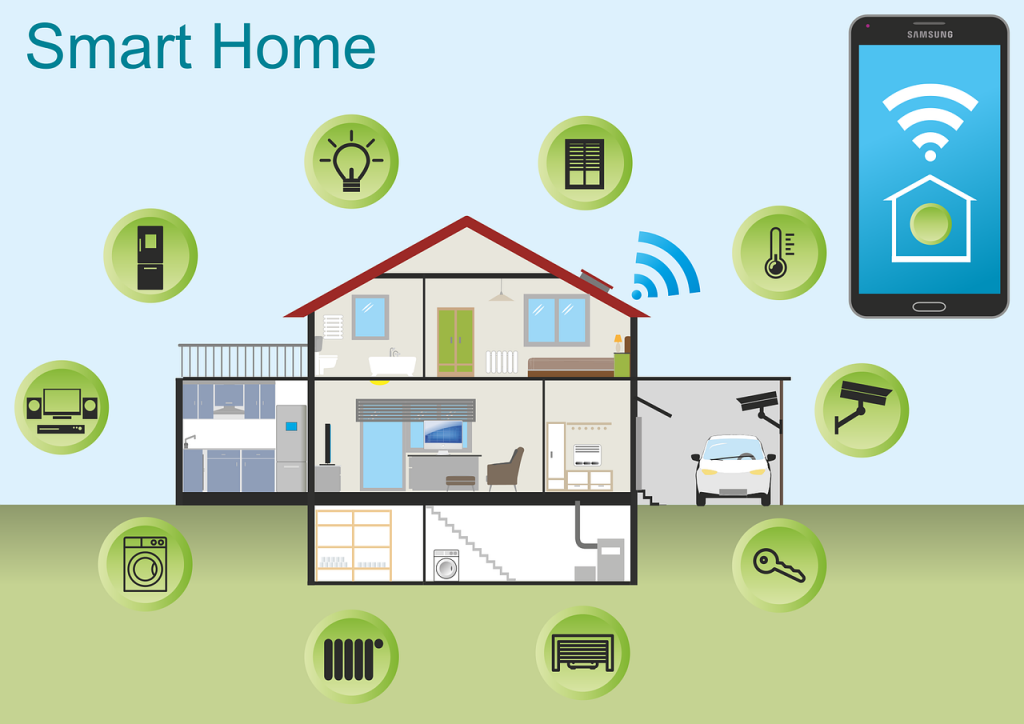The Internet of Things (IoT) consists of hardware and software frameworks that combine to sense, capture, actuate and process data about the physical world. Typically, they can be in the form of embedded sensors (edge devices) in products or the environment.
The smart home is one of the most popular application areas enjoying wide adoption from consumers. One of the reasons would be that the home is the ideal place where IoT has the capacity to help users with automation and insights for efficient handling and monitoring of everyday appliances. So from dish washers to microwave oven and washing machines, all are getting smarter.

Pixaline / Pixabay
The building blocks of IoT for the home are very much the same technology as in many other application areas.
The IoT technology stack for a smart home looks like:
- A house with lots of Edge devices- sensors, actuators, meters
- Gateway device- serves as home management system or BMS (building management system).
- Data storage and BMS control for say (home security) is controlled by a digital service, internet and API).
- The digital service may have a Web interface/UI for users to access locally or remotely.
But to implement these myriad of technology, we need to think about the connectivity, interaction, accessibility and privacy combine to deliver a unique experience for users.
Connectivity: IoT translate IP-based communications and local, non-IP networks used to connect the gateway to the Edge devices. In most cases, the smartphone can also act as a gateway via Bluetooth or NFC. The smartphone would have an onboard app that interacts directly with the device. Home owners won’t have to hustle for ways to control the device, the smartphone already has the computing capacity and power to function as a gateway as well as interact with the embedded device.
On the other hand, a smartphone is not a suitable gateway for devices that needs connectivity when the user is not around. For example, a connected home system that needs to function when the house is unoccupied (e.g. to run a security alarm) needs a gateway that is permanent at home. It makes sense that vendors consider building gateways into popular home devices/appliances such as WiFfi routers, fire alarms and thermostats or TV decoders.
Interaction: System data around the home requires Internet service to collect, process and distribute data and commands. There are many options to consider as to where processing happens; in the cloud, gateway or Edge device? Each choice has its pros and cons depending on what the device is meant to achieve.
For instance, the Cloud processing makes it easier to maintain and update system data as well as have a centralized view of the system. On the other hand, the system won’t work when devices lose connectivity and not able to access the Cloud. A use case would be air monitoring data; whereas the data may not be urgent when the system loses connectivity, it can always be downloaded and accessed when connectivity is back on.
But if the data needs to be accessed urgently for example, facial recognition camera scanning your face in order to open the gates. In this case, local processing is the required option. So the device can work without the internet using a gateway or onboard controls to activate and actuate the locks.
Access & accessibility: The smart home focuses on making the lives of users easier and safer by making devices and appliances accessible. The integration of new technologies makes it hard to sometimes involve people with disabilities and elderly but that shouldn’t be. In fact, the goal is to help people manage and control their lives and homes. One way to do this is for vendors and system designers to create highly visible digital interfaces that mirror the specific affordances typical on the hardware. So, buttons on a washing machine could be replaced exactly with a touch screen or app interface.
In designing such digital interfaces, it’s important to observe and adhere to a universal code of accessibility that caters to users that may be visually impaired, with disabilities and older people.
One way to create accessibility for connected products based on web-of-things (i.e. products with control and interaction via Web and mobile apps) to use exiting platforms. Accessibility is already built into Web browsers and mobile platforms such as Android and iOS. Areas to think through during the development process; voice interfaces, gestural inputs, tactile interfaces and context-sensitive interfaces. Hopefully developments in AI, computer vision and natural language processing will reduce unnecessary inputs by users in the future.
Privacy: Perhaps one of the most important factors for IoT devices in the home and a very relevant issue at the moment. Privacy is an issue of networked data. Collecting information about people and making it available. Collecting information about people and making it available.
Organising house device protocols and permissions also falls under this remit. For example; it’s okay to monitor kids and elderly people 24/7, what should be monitored and who has access to this data.
Some general rule, only alert people where necessary. Choose options that make the flow of data manageable, collect only data you can use immediately and don’t sell this data. Since the Facebook/Cambridge Analytica revelation, governments are opening up policy channels and new regulations to protect consumers. The recent EU GDPR regulation is a good step on one hand and it is expected that a more robust IoT privacy regulation be put in place to tackle the complex nature of IoT and the fact that data is the major enabler of IoTs. There are many other factors that are important such as security, interoperability and interusability. These and many more can also add towards creating a user-centric smart home appliances and applications of the future.
In the end, the smart home is a network of connected devices and appliances; it is about data and using it to improve behaviours and driving efficiencies in the home. Making people feel confident and in control of their lives.
All information/views/opinions expressed in this article are that of the author. This Website may or may not agree with the same.
 Charles Ikem is a service designer with expertise in UI/UX, interaction design, data science and digital transformation. Charles has worked for CELT, UK, Centre for Technology Entrepreneurship in Italy as well as in South Africa and Nigeria. He holds a Master’s Degree in Design Management from Birmingham City University, UK and a PhD from University of Padova, Italy where he worked on service design applications to Internet of Things. Charles is currently working as an independent consultant for M4ID based in Helsinki.
Charles Ikem is a service designer with expertise in UI/UX, interaction design, data science and digital transformation. Charles has worked for CELT, UK, Centre for Technology Entrepreneurship in Italy as well as in South Africa and Nigeria. He holds a Master’s Degree in Design Management from Birmingham City University, UK and a PhD from University of Padova, Italy where he worked on service design applications to Internet of Things. Charles is currently working as an independent consultant for M4ID based in Helsinki.
